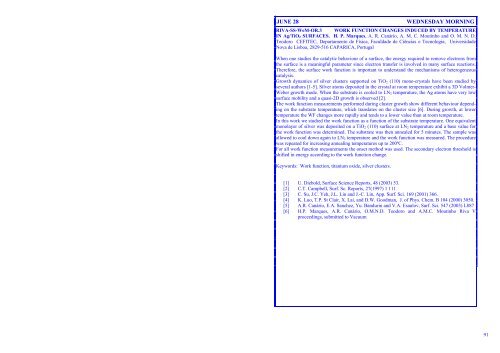Wüest M. 51 Wykes M. 82 Yamaguchi M. 17 Ybarra G. 129 Yubero F ...
Wüest M. 51 Wykes M. 82 Yamaguchi M. 17 Ybarra G. 129 Yubero F ...
Wüest M. 51 Wykes M. 82 Yamaguchi M. 17 Ybarra G. 129 Yubero F ...
Create successful ePaper yourself
Turn your PDF publications into a flip-book with our unique Google optimized e-Paper software.
JUNE 28 WEDNESDAY MORNING<br />
RIVA-SS-WeM-OR.3 WORK FUNCTION CHANGES INDUCED BY TEMPERATURE<br />
IN Ag/TiO 2 SURFACES. H. P. Marques, A. R. Canário, A. M. C. Moutinho and O. M. N. D.<br />
Teodoro CEFITEC, Departamento de Física, Faculdade de Ciências e Tecnologia, Universidade<br />
Nova de Lisboa, 2<strong>82</strong>9-<strong>51</strong>6 CAPARICA, Portugal<br />
When one studies the catalytic behaviour of a surface, the energy required to remove electrons from<br />
the surface is a meaningful parameter since electron transfer is involved in many surface reactions.<br />
Therefore, the surface work function is important to understand the mechanisms of heterogeneous<br />
catalysis.<br />
Growth dynamics of silver clusters supported on TiO 2 (110) mono-crystals have been studied by<br />
several authors [1-5]. Silver atoms deposited in the crystal at room temperature exhibit a 3D Volmer-<br />
Weber growth mode. When the substrate is cooled to LN 2 temperature, the Ag atoms have very low<br />
surface mobility and a quasi-2D growth is observed [2].<br />
The work function measurements performed during cluster growth show different behaviour depending<br />
on the substrate temperature, which translates on the cluster size [6]. During growth, at lower<br />
temperature the WF changes more rapidly and tends to a lower value than at room temperature.<br />
In this work we studied the work function as a function of the substrate temperature. One equivalent<br />
monolayer of silver was deposited on a TiO 2 (110) surface at LN 2 temperature and a base value for<br />
the work function was determined. The substrate was then annealed for 5 minutes. The sample was<br />
allowed to cool down again to LN 2 temperature and the work function was measured. The procedure<br />
was repeated for increasing annealing temperatures up to 200ºC.<br />
For all work function measurements the onset method was used. The secondary electron threshold is<br />
shifted in energy according to the work function change.<br />
Keywords: Work function, titanium oxide, silver clusters.<br />
[1] U. Diebold, Surface Science Reports, 48 (2003) 53.<br />
[2] C.T. Campbell, Surf. Sc. Reports, 27(1997) 1 111<br />
[3] C. Su, J.C. Yeh, J.L. Lin and J.-C. Lin, App. Surf. Sci. 169 (2001) 366.<br />
[4] K. Luo, T.P. St Clair, X. Lai, and D.W. Goodman, J. of Phys. Chem. B 104 (2000) 3050.<br />
[5] A.R. Canário, E.A. Sanchez, Yu. Bandurin and V.A. Esaulov, Surf. Sci. 547 (2003) L887<br />
[6] H.P. Marques, A.R. Canário, O.M.N.D. Teodoro and A.M.C. Moutinho Riva V<br />
proceedings, submitted to Vacuum<br />
91
















